Sure, our island is a tropical paradise with sun and sand all around, but there is also ample history in our midst. And since winter may not be the best time to enjoy the surf anyway, it’s a good time to get out and discover the historical markers dotting the island. So, dust off the golf cart or bike and check out these local history highlights.
COL. WILLIAM “DANGER” THOMSON PARK
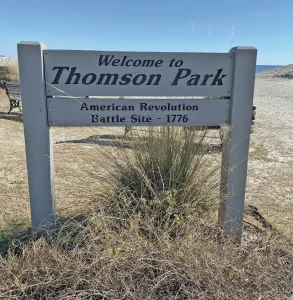 Let’s start at the beginning – the beginning of the island, that is. Just across Breach Inlet, technically on Sullivan’s Island, is a historical marker at Thomson Park. If you’ve been around awhile, you probably know that the park is named for Col. William “Danger” Thomson who, during the Revolutionary War, led American Patriots in repelling a British attack from our side of the inlet. The inlet was much wider back then, but just as today, it was deceptive in its appearance and lured the Brits into thinking it was safe enough to cross at low tide. As they attempted the crossing on foot and in rowboats, they were met with grapeshot fired by Patriots on Sullivan’s Island. American forces were outnumbered almost 3 to 1, yet their fortitude and tenacity signaled to the British that Thomson’s men were not going to give up.
Let’s start at the beginning – the beginning of the island, that is. Just across Breach Inlet, technically on Sullivan’s Island, is a historical marker at Thomson Park. If you’ve been around awhile, you probably know that the park is named for Col. William “Danger” Thomson who, during the Revolutionary War, led American Patriots in repelling a British attack from our side of the inlet. The inlet was much wider back then, but just as today, it was deceptive in its appearance and lured the Brits into thinking it was safe enough to cross at low tide. As they attempted the crossing on foot and in rowboats, they were met with grapeshot fired by Patriots on Sullivan’s Island. American forces were outnumbered almost 3 to 1, yet their fortitude and tenacity signaled to the British that Thomson’s men were not going to give up.
BREACH INLET
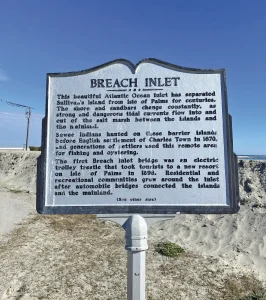 For many years, the bridge was named for Thomson, but it was renamed in memory of the crew of the H.L. Hunley, which docked at the inlet during the Civil War. This Confederate submarine ran numerous exercises from there and was deployed in February 1864 when it set out to attack a U.S. naval vessel that was blockading the entrance to the harbor. The mission was successful and sank the USS Housatonic, but the whereabouts of the Hunley and its crew remained a mystery for the next 136 years until finally being recovered several miles offshore. The historical marker also references the Sewee tribe as being the first part-time residents of both islands, long before any white settlers arrived on our shores, as well as visitors who came centuries later via trolley to enjoy the first resort on the Isle of Palms in 1898.
For many years, the bridge was named for Thomson, but it was renamed in memory of the crew of the H.L. Hunley, which docked at the inlet during the Civil War. This Confederate submarine ran numerous exercises from there and was deployed in February 1864 when it set out to attack a U.S. naval vessel that was blockading the entrance to the harbor. The mission was successful and sank the USS Housatonic, but the whereabouts of the Hunley and its crew remained a mystery for the next 136 years until finally being recovered several miles offshore. The historical marker also references the Sewee tribe as being the first part-time residents of both islands, long before any white settlers arrived on our shores, as well as visitors who came centuries later via trolley to enjoy the first resort on the Isle of Palms in 1898.
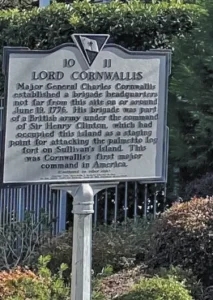 LORD CORNWALLIS
LORD CORNWALLIS
The first historical marker on our side of the inlet is located at 120 Charleston Blvd., identifying it as the approximate location of the British troops who attempted the attack at Breach Inlet in 1776. Maj. Gen. Charles Cornwallis and his soldiers were prevented from crossing Breach Inlet and defeated.
THE LOGGERHEAD SEA TURTLE
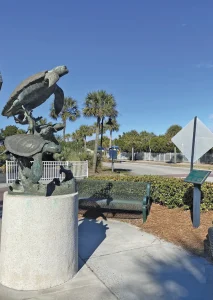 On Ocean Boulevard between 10th and 14th avenues is an interesting feature that is likely overlooked by visitors jockeying to find a parking space there. But now that things are quiet, you can take time to check out what is technically not a historical marker but an important slice of history, nonetheless. A section of the median is made of bricks donated by island residents and businesses who made the island the wonderful community that it has always been. Read through the names to find those of your friends and neighbors. On either end of the walkway are plaques spotlighting the island’s unofficial mascot, the loggerhead sea turtle, whose astonishing journey of life begins on our shores.
On Ocean Boulevard between 10th and 14th avenues is an interesting feature that is likely overlooked by visitors jockeying to find a parking space there. But now that things are quiet, you can take time to check out what is technically not a historical marker but an important slice of history, nonetheless. A section of the median is made of bricks donated by island residents and businesses who made the island the wonderful community that it has always been. Read through the names to find those of your friends and neighbors. On either end of the walkway are plaques spotlighting the island’s unofficial mascot, the loggerhead sea turtle, whose astonishing journey of life begins on our shores.
CLYDE M. DANGERFIELD BRIDGE (IOP CONNECTOR)
At the foot of the Clyde M. Dangerfield Bridge (aka the Connector) stands a green highway marker designating the roadway as a Blue Star Memorial Highway. These markers are found across the country and honor the men and women of our armed forces. The blue star icon was first displayed during World War II on the homes of families who had a loved one serving in the military.
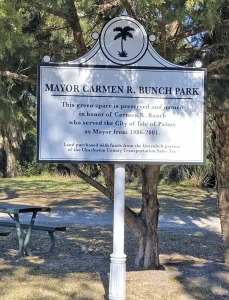 MAYOR CARMEN R. BUNCH PARK
MAYOR CARMEN R. BUNCH PARK
Just past Island Center is the Mayor Carmen R. Bunch Park, named for the island’s first (and only) woman mayor. She led the city for 15 years, including the tumultuous period during and after Hurricane Hugo. The sign is the focal point of this quiet and somewhat hidden space, perfect for a picnic lunch or rest stop in your exploration of the island’s past.
PLANT-A-PALM COMMITTEE
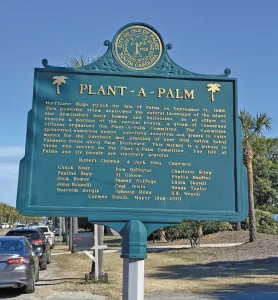 Your final stop along the route, just past the curve of Palm Boulevard at 21st Avenue, is a large green sign commemorating the efforts of the Plant-A-Palm Committee, a group of folks who raised money to plant 800 sabal palmetto trees along Palm Boulevard after Hurricane Hugo devastated the island in 1989. Now that you have taken some time to explore the island’s past, go about your daily travels with a greater appreciation of the history that surrounds us.
Your final stop along the route, just past the curve of Palm Boulevard at 21st Avenue, is a large green sign commemorating the efforts of the Plant-A-Palm Committee, a group of folks who raised money to plant 800 sabal palmetto trees along Palm Boulevard after Hurricane Hugo devastated the island in 1989. Now that you have taken some time to explore the island’s past, go about your daily travels with a greater appreciation of the history that surrounds us.
By Mary Coy

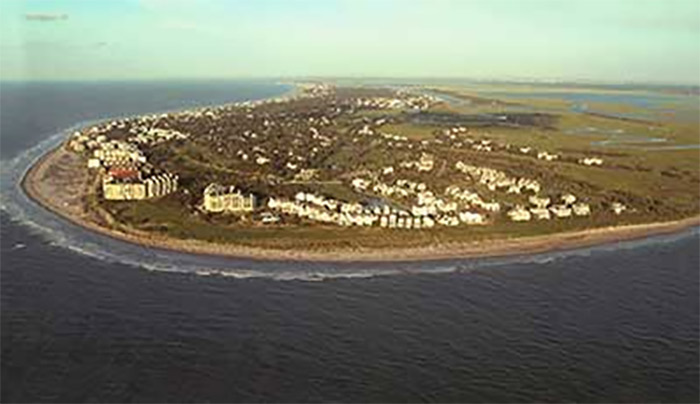

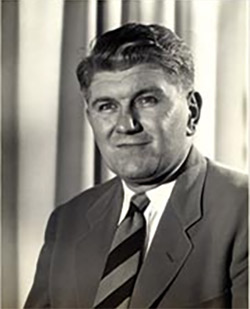
Leave a Reply